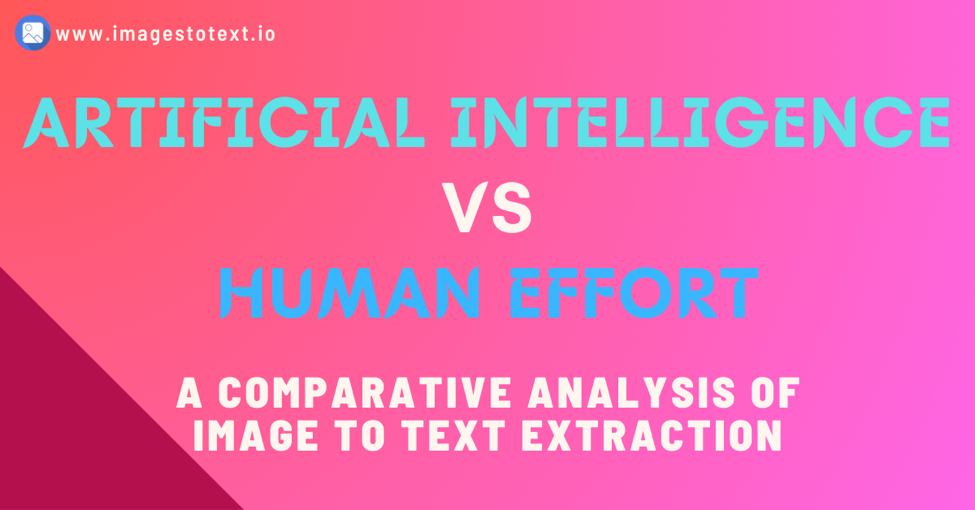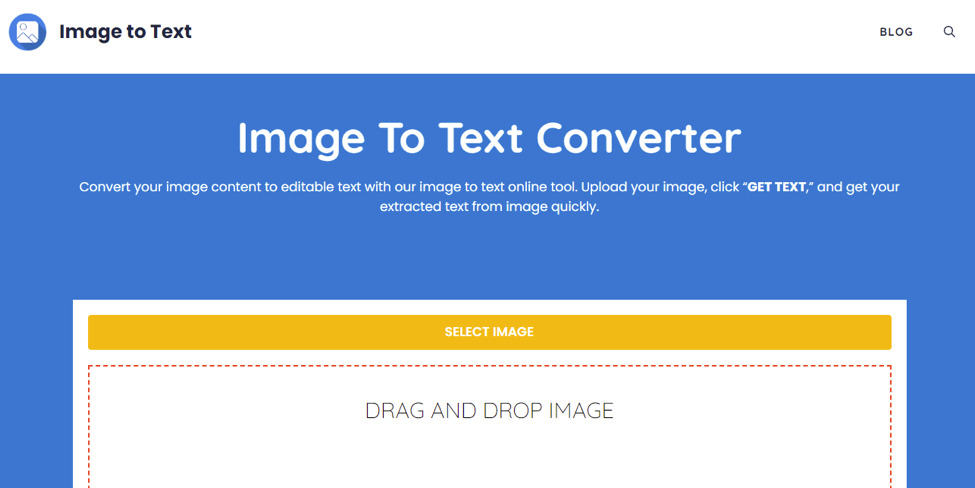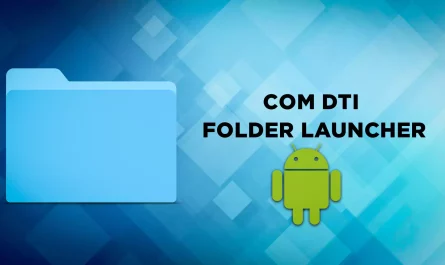As we know that the capabilities of Artificial Intelligence (AI) have become increasingly sophisticated, raising questions about the balance between human effort and machine intelligence.
One captivating area of examination lies in the realm of image to text extraction, where AI systems endeavor to decipher visual information and convert it into textual content.

This comparative analysis aims to explore the strengths and limitations of AI driven picture to text extraction in contrast to the expertise of human effort. Let’s start from comaring both the AI and Human efforts from differnet perspectivves:
Contents
- 1 Artificial Intelligence vs Human Effort for Image to Text Extraction
- 2 Image to Text Extraction Via Artificial Intellegence
- 3 Advantages of AI Image to Text Extraction:
- 4 Disadvantages of AI Image to Text Extraction:
- 5 Human Efforts in Image to Text Extraction:
- 6 Advantages of human efforts in Image to Text Extraction:
- 7 Disadvantages of human efforts in Image to Text Extraction:
- 8 Summary:
Artificial Intelligence vs Human Effort for Image to Text Extraction
| Aspects | Artificial Intelligence | Human Effort |
| Speed | Rapidly processes large datasets | Slower in processing due to cognitive limitations |
| Accuracy | High accuracy in extracting text from images | Prone to errors and subjective interpretations |
| Scalability | Scalable for handling massive amounts of data | Limited capacity for processing large volumes |
| Contextual Understanding | Limited ability to grasp contextual nuances | Proficient in discerning contextual information |
| Adaptability | Can learn and improve over time with training | Possesses inherent adaptability and intuition |
| Cognitive Abilities | Lacks intuition and human like understanding | Inherently possesses intuition and reasoning |
| Complex Scenarios | Struggles with complex and abstract scenarios | Excels in deciphering intricate visual details |
| Reliability | Consistent performance under defined conditions | Varies based on individual expertise and effort |
| Cost | Initial investment and maintenance costs | Salaries, training, and potential human errors |
AI demonstrates remarkable speed, scalability, and accuracy in processing large datasets and extracting text from images. It excels in scenarios where vast amounts of visual information need to be rapidly processed. However, AI systems may struggle with contextual understanding, complex scenarios, and intuitive reasoning.
On the other hand, human effort possesses inherent cognitive abilities, such as contextual understanding, intuition, and adaptability. Humans excel in discerning intricate visual details, grasping abstract concepts, and inferring meaning from visual cues.
This synergy between AI and human effort paves the way for enhanced photo to text extraction capabilities, promising exciting possibilities for future advancements in this field.
Image to Text Extraction Via Artificial Intellegence
Image to Text Conveter Tools are the source of converting texts from pictures into editable sentences. With the advancements in Artificial Intelligence (AI), specifically in the field of image recognition and natural language processing, picture to text extraction has emerged as a fascinating area of study.
This process involves leveraging AI algorithms and deep learning models to decipher textual content from images, opening up a realm of possibilities for various industries.
By harnessing the power of AI, photo to text ai tool holds the potential to revolutionize fields such as document processing, content analysis, accessibility services, and more.
One of the best and simplest to use picture to text converter is “ImagestoText.io” It is free to use and involve sonly 3 steps to convert a photo into text. It allows JPG, PNG, SVG, and GIF image extensions.

Advantages of AI Image to Text Extraction:
- Speed and Efficiency:
AI photo to text extraction can rapidly process large volumes of visual data, enabling quick and efficient extraction of textual content from images.
- Accuracy and Consistency:
AI algorithms can achieve high levels of accuracy in extracting text from images, reducing errors and ensuring consistent results.
- Scalability:
AI systems can handle massive amounts of visual data, making them highly scalable for processing and extracting text from a large number of images.
- Automation and Productivity:
AI picture to text extraction eliminates the need for manual effort, increasing productivity by automating the process and freeing up human resources for more complex tasks.
- Versatility and Applications:
AI photo to text extraction has diverse applications across various industries, including document processing, content analysis, image recognition, and accessibility services, enhancing efficiency and expanding possibilities.
Disadvantages of AI Image to Text Extraction:
- Contextual Understanding Limitations:
Image to text tool systems may struggle to grasp contextual nuances and infer meaning accurately from visual cues, leading to potential misinterpretations or incomplete understanding of the text within the image.
- Training and Maintenance:
Developing and maintaining AI models for picture to text extraction can be resource intensive, requiring substantial initial investment, ongoing training, and updates to keep up with evolving data and technologies.
- Lack of Intuition and Creativity:
AI systems lack human like intuition, creativity, and reasoning abilities, which can limit their ability to accurately interpret and extract text in situations that require subjective analysis or contextual understanding.
Human Efforts in Image to Text Extraction:
Human efforts play a crucial role in deciphering and extracting textual information from visual content. Harnessing the innate cognitive abilities of humans, this process involves the application of human expertise, contextual understanding, and intuition to analyze and interpret the text within images.
While Artificial Intelligence (AI) has made significant strides in this domain, human efforts bring a unique set of advantages to the table.
Humans possess the ability to discern subtle nuances, understand complex contexts, and make subjective judgments that can be challenging for AI systems. Here are a few prominent advantages and the associated disadvantages or lacks in harnessing human effort in picture to text extraction:
Advantages of human efforts in Image to Text Extraction:
- Subjective Interpretations:
Human effort allows for subjective interpretations and the application of domain expertise, enabling the extraction of implicit meanings and providing a more nuanced understanding of the textual content derived from images.
- Cognitive Flexibility:
Humans can adapt to new and unfamiliar scenarios, allowing them to handle diverse types of images and extract text even in challenging or unconventional situations that AI systems may struggle with.
- Domain Specific Knowledge:
Human experts bring domain specific knowledge and expertise, enabling them to recognize specialized terminology, jargon, or domain specific contexts that may not be readily understood by AI algorithms.
- Contextual Understanding:
Humans possess the ability to comprehend complex visual contexts, including nuances, symbolism, and cultural references, which can greatly enhance the accuracy and depth of photo to text extraction.
- Complex Reasoning:
Humans possess higher order cognitive abilities, such as critical thinking and reasoning, which allow them to make connections, infer implications, and uncover underlying concepts or messages embedded within images.
Disadvantages of human efforts in Image to Text Extraction:
- Subjectivity and Bias:
Human interpretations can be subjective and influenced by personal perspectives, cultural biases, or individual experiences, potentially introducing unintentional errors or distortions in the extracted text.
- Time and Resource Constraints:
Human effort is limited by time and resource constraints, making it impractical for processing large volumes of images in a timely manner, especially when dealing with real time or high throughput applications.
- Inconsistency:
Human efforts may exhibit inconsistency in the extraction process due to factors like fatigue, varying levels of expertise, or differences in individual interpretation, leading to variations in the accuracy and quality of the extracted text.
- Scalability Challenges:
Scaling human efforts to handle a large number of images can be logistically challenging and expensive, requiring significant manpower, training, and coordination.
- Errors and Human Limitations:
Humans are prone to making errors, overlooking details, or misinterpreting visual cues, which can introduce inaccuracies in the extracted text. Similarly, cognitive limitations such as attention span and memory constraints can affect the reliability and consistency of human performance.
Summary:
It is concluded that AI demonstrates remarkable speed, scalability, and accuracy in processing vast amounts of visual data, providing efficient extraction of text from images.
While human effort brings essential cognitive abilities, such as contextual understanding, subjective interpretations, and adaptability, enabling the extraction of nuanced information and grasping intricate visual details.
At the same time, human efforts are limited by subjectivity, time constraints, scalability challenges, and the potential for errors. However, the optimal approach lies in harnessing the strengths of both AI and human effort, leveraging AI’s efficiency in processing large datasets while relying on human expertise to handle complex scenarios and ensure accurate interpretations.



